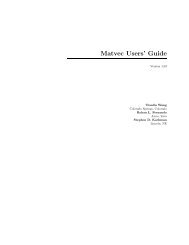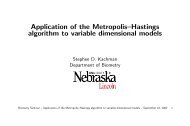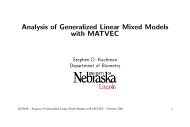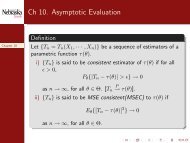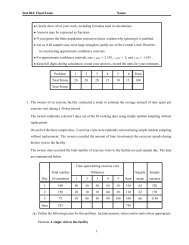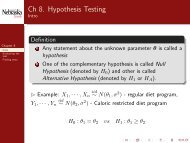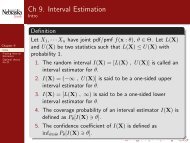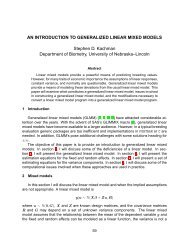Biometry 802 Experimental Design
Blocking and Randomized Complete Block Designs - Department of ...
Blocking and Randomized Complete Block Designs - Department of ...
Create successful ePaper yourself
Turn your PDF publications into a flip-book with our unique Google optimized e-Paper software.
<strong>Biometry</strong> <strong>802</strong><br />
<strong>Experimental</strong> <strong>Design</strong><br />
S. D. Kachman<br />
Department of <strong>Biometry</strong><br />
University of Nebraska–Lincoln<br />
http://www.ianr.unl.edu/ianr/biometry/faculty/steve/<strong>802</strong>/2000
Randomized Complete Block <strong>Design</strong>s –<br />
Introduction<br />
Outline<br />
• Blocking<br />
• <strong>Design</strong><br />
• Model<br />
• Estimation<br />
• ANOVA<br />
• Testing<br />
<strong>Biometry</strong> <strong>802</strong> – <strong>Experimental</strong> <strong>Design</strong> – Fall 2000 64
Blocking<br />
• In a CRD assignment takes place completely at random<br />
– Each treatment has an equal chance to be assigned to<br />
a more or less favorable material<br />
– Some treatments will be assigned to more favorable<br />
material<br />
– The role of the analysis is to determine how much of<br />
the observed differences can be accounted for by<br />
chance<br />
• Many times it is possible for the researcher to<br />
systematically group the experimental material into<br />
“blocks” of similar material<br />
– Continuous sources<br />
∗ Light, Temperature, and Moisture<br />
– Discrete Sources<br />
∗ Locations, Days, and Operators<br />
• By assigning each treatment to each block the distribution<br />
of experimental material will be more equitable<br />
– Each treatment will receive an equal allocation of<br />
favorable material.<br />
– The ability of the experimenter to group the material will<br />
determine the effectiveness of blocking<br />
– A poor job of blocking will result in a weaker experiment<br />
<strong>Biometry</strong> <strong>802</strong> – <strong>Experimental</strong> <strong>Design</strong> – Fall 2000 65
<strong>Design</strong><br />
Divide <strong>Experimental</strong> Units into subsets<br />
• Subsets are Different<br />
• <strong>Experimental</strong> Units within subsets are homogeneous<br />
r Blocks<br />
t Treatments<br />
• Each treatment in every block<br />
• Randomly assign treatments to experimental units within<br />
each block<br />
<strong>Biometry</strong> <strong>802</strong> – <strong>Experimental</strong> <strong>Design</strong> – Fall 2000 66
Block 1 Block 2 Block 3 Block 4<br />
<strong>Biometry</strong> <strong>802</strong> – <strong>Experimental</strong> <strong>Design</strong> – Fall 2000 67
Formula<br />
y ij = µ + τ i + β j + e ij<br />
β j ∼ N(0, σ 2 B )<br />
e ij ∼ N(0, σ 2 )<br />
• β j ’s and e ij ’s are independently distributed<br />
<strong>Biometry</strong> <strong>802</strong> – <strong>Experimental</strong> <strong>Design</strong> – Fall 2000 68
Model<br />
• Expected Value<br />
E(y ij ) = µ + τ i<br />
• Dispersion<br />
var(y ij ) = σ 2 + σ 2 B<br />
cov(y ij , y i ′ j ) = σ 2 B<br />
cov(y ij , y i ′ j ′) = 0<br />
• Distribution – Normal<br />
• Treatment differences<br />
– Estimator ȳ 1· − ȳ 2·<br />
– Standard Error ̂σȳ1·−ȳ 2· =<br />
√<br />
MSE 2 r<br />
<strong>Biometry</strong> <strong>802</strong> – <strong>Experimental</strong> <strong>Design</strong> – Fall 2000 69
ANOVA<br />
Source df SS MS EMS F<br />
Block r − 1 SSBlock MSBlock tσ 2 β + σ2<br />
Treat t − 1 SStrt MStrt rκ 2 τ + σ2 F<br />
Error (r − 1)(t − 1) = rt − r − t + 1 SSerror MSerror σ 2<br />
Of course actual numbers would be used in the df, SS, MS, F, and p-value columns.<br />
SSBlock =<br />
∑ r<br />
j=1 y2·j<br />
t<br />
− y2··<br />
rt<br />
SST rt =<br />
SSError =<br />
∑ t<br />
i=1 y2 i·<br />
r<br />
t∑ r∑<br />
i=1<br />
j=1<br />
− y2··<br />
rt<br />
y 2 ij − ∑ t<br />
i=1 y2 i·<br />
r<br />
−<br />
∑ r<br />
j=1 y2·j<br />
t<br />
+ y2··<br />
rt<br />
<strong>Biometry</strong> <strong>802</strong> – <strong>Experimental</strong> <strong>Design</strong> – Fall 2000 70
Testing<br />
• t-tests for single degree of freedom contrasts<br />
• F-test for multiple degree of freedom contrasts<br />
• Use error degrees of freedom from ANOVA<br />
• Multiple comparison procedures and Confidence Intervals<br />
as before<br />
<strong>Biometry</strong> <strong>802</strong> – <strong>Experimental</strong> <strong>Design</strong> – Fall 2000 71
RCBD–Example Emergence Rate<br />
Outline<br />
• Layout<br />
• <strong>Design</strong><br />
– Treatment and <strong>Experimental</strong><br />
• Formula<br />
• Analysis<br />
• Conclusions<br />
<strong>Biometry</strong> <strong>802</strong> – <strong>Experimental</strong> <strong>Design</strong> – Fall 2000 72
Layout<br />
Comparing 4 treatments of soybeans and an untreated<br />
control on the emergence rate of soybeans. The following<br />
layout was used:<br />
Rep 1 Rep 2 Rep 3 Rep 4 Rep 5<br />
<strong>Biometry</strong> <strong>802</strong> – <strong>Experimental</strong> <strong>Design</strong> – Fall 2000 73
<strong>Design</strong><br />
• Treatment <strong>Design</strong><br />
– Treatment factor – Seed treatment<br />
– Treatment levels (5) – Check, Arasan, Spergon,<br />
Semesan Jr., and Fermate<br />
• <strong>Experimental</strong> <strong>Design</strong><br />
– The field is located on a slope<br />
– Form blocks based on elevation<br />
– 5 plots at each elevation<br />
– 5 replications of a RCBD<br />
• Data consists of the number of plants that emerge out of a<br />
total 100 that were planted<br />
– Binomial may be a better choice for the distribution<br />
<strong>Biometry</strong> <strong>802</strong> – <strong>Experimental</strong> <strong>Design</strong> – Fall 2000 74
Formula<br />
y ij = µ + τ i + β j + e ij<br />
• y ij emergence rate of seeds treated with treatment i in<br />
Block j<br />
• µ overall average emergence rate<br />
• τ i increase in emergence rate for seeds treated with<br />
treatment i<br />
• β j increase in emergence rate for seeds planted in block j<br />
• e ij increase in emergence rate for using treatment i in<br />
block j<br />
<strong>Biometry</strong> <strong>802</strong> – <strong>Experimental</strong> <strong>Design</strong> – Fall 2000 75
Analysis<br />
Source df MS EMS F p-value<br />
Rep 4 12.46 σ 2 + 5σ 2 β<br />
2.30 .1032<br />
Treat 4 20.96 σ 2 + 5κ 2 τ<br />
3.87 .0219<br />
Cont vs rest 1 67.41 σ 2 + Q 1 12.46 .0028<br />
Rest 3 5.53 σ 2 + Q 2 1.02 .4087<br />
Error 16 5.41 σ 2<br />
V ar(ȳ Ch· − .25 ∑<br />
i≠Ch<br />
y i·) = V ar(ē Ch· − .25 ∑<br />
= σ2<br />
5 + σ2<br />
20<br />
= σ 2 5<br />
20<br />
= σ 21 + 4 1<br />
16<br />
5<br />
i≠Ch<br />
ē i·)<br />
<strong>Biometry</strong> <strong>802</strong> – <strong>Experimental</strong> <strong>Design</strong> – Fall 2000 76
Check versus rest<br />
̂γ ± t .05,16̂σ̂γ<br />
̂γ = 1(10.8) −<br />
̂σ̂γ =<br />
= −4.1<br />
√<br />
= 1.16<br />
t .05,16 = 2.12<br />
−6.5 < γ < −1.65<br />
6.2 + 8.2 + 6.6 + 5.8<br />
4<br />
5.41 12 + 4 × (1/4) 2<br />
5<br />
We are 95% percent confident that on average the<br />
emergence rate of the treated seeds is between 6.5% and<br />
1.7% more than the emergence rate of the untreated control.<br />
<strong>Biometry</strong> <strong>802</strong> – <strong>Experimental</strong> <strong>Design</strong> – Fall 2000 77
Conclusions<br />
• Treating seeds does have an effect on emergence rate<br />
• There was not a significant difference between the four<br />
treatments<br />
• It might be of interest to check if the four treatment are<br />
“equivalent”<br />
<strong>Biometry</strong> <strong>802</strong> – <strong>Experimental</strong> <strong>Design</strong> – Fall 2000 78
Summary RCBD<br />
• CRD versus RCBD<br />
• Building with blocks<br />
• Analysis<br />
<strong>Biometry</strong> <strong>802</strong> – <strong>Experimental</strong> <strong>Design</strong> – Fall 2000 79
CRD versus RCBD<br />
• The biggest advantage of a CRD is its simplicity<br />
• If we do good job constructing blocks, the advantage of a<br />
RCBD is greater precision<br />
• With a large number of treatments it can be difficult to<br />
form effective blocks<br />
• The CRD and RCBD are both examples of experimental<br />
designs<br />
• At the analysis stage: It is the randomization used that<br />
drives what analysis to use<br />
• There are often times when a CRD is a better design<br />
– Forming blocks for the sake of forming blocks is<br />
generally not a good idea<br />
– Blocking incorrectly will make matters worse<br />
<strong>Biometry</strong> <strong>802</strong> – <strong>Experimental</strong> <strong>Design</strong> – Fall 2000 80
Relative efficiency<br />
• Was blocking effective?<br />
• Based on looking at the number of replications needed to<br />
obtain the same standard for a difference<br />
n CRD = 2σ2 CR<br />
δ 2<br />
n RCBD = 2σ2 RCBD<br />
δ 2<br />
n CRD<br />
n RCBD<br />
= σ2 CRD<br />
σ 2 RCBD<br />
• From the RCBD an ̂σ 2 RCBD = MSE<br />
• After some algebra,<br />
̂σ 2 CRD<br />
=<br />
(r − 1)MSBlock + r(t − 1)MSE<br />
rt − 1<br />
• For the emergence rate experiment<br />
re =<br />
(5 − 1)12.46 + 5(5 − 1)5.41<br />
(5 ∗ 5 − 1)5.41<br />
= 1.22<br />
<strong>Biometry</strong> <strong>802</strong> – <strong>Experimental</strong> <strong>Design</strong> – Fall 2000 81
• Therefore to obtain the same precision we would need<br />
about 6 replications of a CRD versus 5 replications of a<br />
RCBD<br />
<strong>Biometry</strong> <strong>802</strong> – <strong>Experimental</strong> <strong>Design</strong> – Fall 2000 82
Building with blocks<br />
• Subjects/Plots/Animals within a block should be as similar<br />
as possible<br />
• Subjects/Plots/Animals is different blocks should be as<br />
different as possible<br />
• Common blocking factors<br />
– Time<br />
– People/Animals/Plants<br />
– Sources of materials<br />
– Locations<br />
– Machines<br />
<strong>Biometry</strong> <strong>802</strong> – <strong>Experimental</strong> <strong>Design</strong> – Fall 2000 83
Analysis<br />
<strong>Biometry</strong> <strong>802</strong> – <strong>Experimental</strong> <strong>Design</strong> – Fall 2000 84
ANOVA<br />
Source df SS MS EMS F<br />
Block r − 1 SSBlock MSBlock tσ 2 β + σ2<br />
Treat t − 1 SStrt MStrt rκ 2 τ + σ2 F<br />
Error (r − 1)(t − 1) = rt − r − t + 1 SSerror MSerror σ 2<br />
<strong>Biometry</strong> <strong>802</strong> – <strong>Experimental</strong> <strong>Design</strong> – Fall 2000 85
Estimates<br />
• As before<br />
<strong>Biometry</strong> <strong>802</strong> – <strong>Experimental</strong> <strong>Design</strong> – Fall 2000 86



